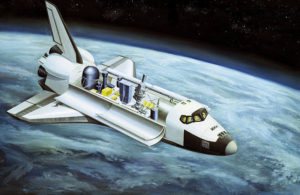Time to go back to the early days of the Space Shuttle program. 1980, in this case, when the first flight was still in the middle of a variety of delays. The Space Shuttle was basically ready, but as luck would have it one thing after another kept the vehicle grounded until April 12th, 1981, and the launch of STS-1.
During this time frame NASA was still working hard to educate the public about just what the Space Transportation System, the official designation for the Space Shuttle program, was actually going to do. This film, like many others we have looked at, is of course incredibly optimistic about the on-orbit tasks the Shuttle was designed, and planned, to do.
What’s really interesting from my knowledge, is just how much of what is proposed in this video actually did happen – in fact, everything up until the tail end was done at least once, or tested. The Manned Maneuvering Unit was test flown, the telescope they speak of being launched on the Shuttle is clearly Hubble, the Long Duration Exposure Facility did get launched, and recovered, as well as a Shuttle crew repairing and re-deploying a stranded communications satellite. The mission to Jupiter? That was Galileo.

Of course, other things didn’t happen – the Shuttle never did fly with liquid-fueled boosters for payloads – only solid-fueled systems. The space station concepts shown, of course, never happened as depicted, but the ideas for an American space station that were being proposed in those early days would eventually evolve into the American section of the International Space Station.
Sadly, the Shuttle never saw the “space truck” purpose it was thought of as originally. The reason, of course, was the Challenger disaster in 1986. Such changed the original plan for the Shuttle to take over all American launches, causing us to switch back to launching many payloads on conventional boosters (in fact, this change in plans is why the Titan IV and the Delta II, among other boosters, were created) and the Shuttle being reserved for missions requiring the human interaction or the Shuttle’s particular payload capacity.
Enough of that though, enjoy the video, as always, and think about how things could have been as well as what we did in spite of flaws in the Shuttle’s design.
